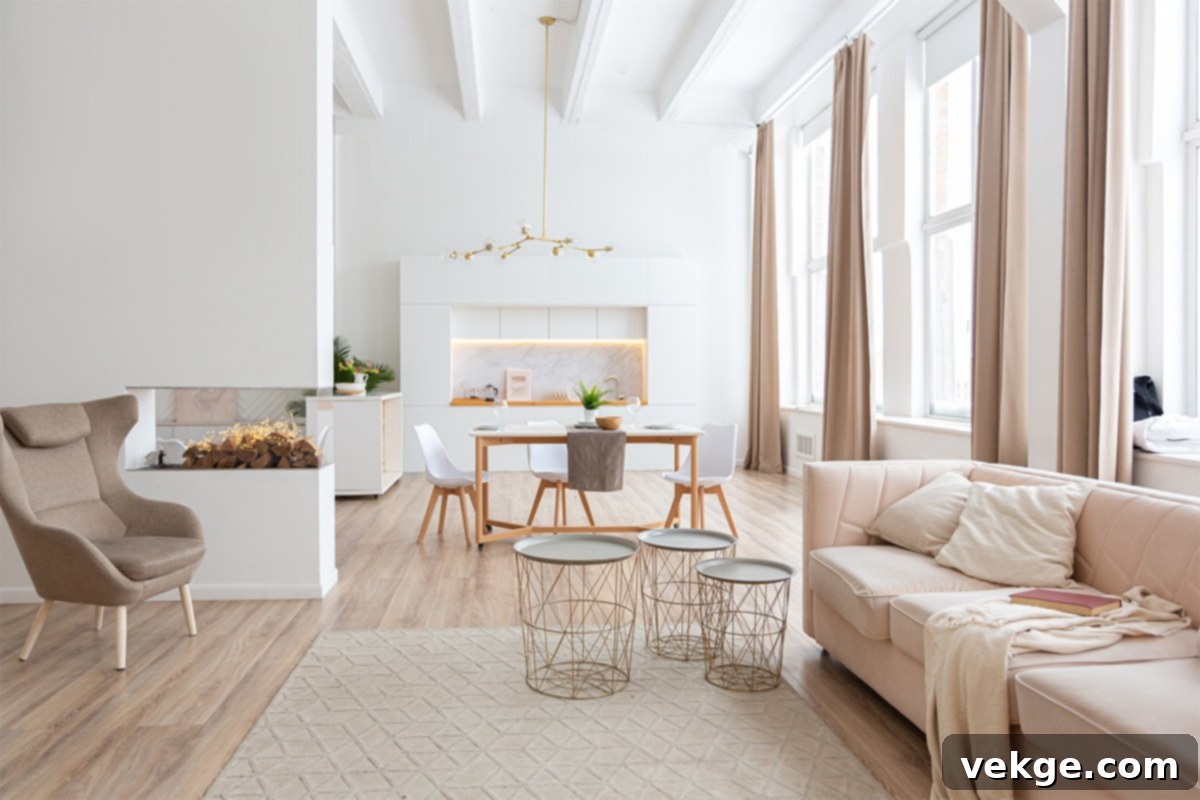Mastering Minimalist Decor: Essential Materials, Principles, and Aesthetic Ideas for Your Home
Minimalism isn’t merely a design trend; it’s a profound philosophy rooted in living with greater intentionality and less clutter. To truly embrace a minimalist lifestyle within your home, you must strive to reduce distractions and furnish your space with items that offer optimal utility, beauty, or sentimental value. Are you considering designing or renovating your house with minimalist decor ideas but feel overwhelmed by deciding which objects truly belong? A highly effective starting point is the ’90-day rule.’
This straightforward guideline suggests a crucial decluttering test: if you haven’t used an item in the past 90 days and don’t anticipate using it in the next 90 days, it likely doesn’t align with the purpose-driven nature of a minimalist home. Beyond this initial decluttering phase, perfecting a minimalist interior also requires a thoughtful consideration of various materials, finishes, and the foundational principles that define this elegant style. Continue reading our comprehensive guide to uncover everything you need to know about creating a serene, functional, and beautifully minimalist living space!
Which Materials Are Recommended for a Minimalistic Design?
A minimalist home is much more than simply reducing the number of objects. It’s about enhancing depth, character, and an enduring elegance through deliberate choices. The right materials are paramount in achieving this sophisticated simplicity, offering distinct textures and visual finishes. Below, we elaborate on some top material recommendations that perfectly align with minimalist aesthetics. Choose the ones that best suit your personal style and functional needs.
1. Wood: Infusing Warmth and Organic Sophistication
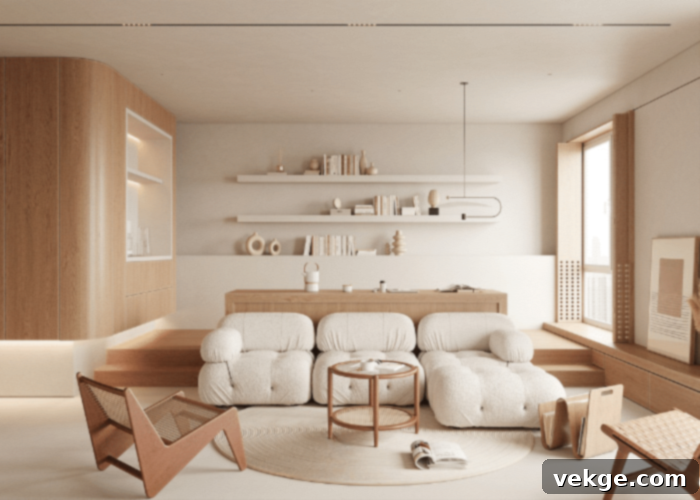
Expertly crafted wooden elements lend a sense of natural maturity and timeless elegance to any minimalist space. Wood instantly connects your home with nature, offering an organic warmth that complements sleek, clean lines. For a truly minimalist feel, prioritize lighter wood tones or those with natural, unvarnished finishes, allowing the inherent beauty of the grain to shine through without excessive embellishment. You don’t have to confine wood solely to traditional furniture like tables, chairs, or sofas. Consider these creative ways to incorporate a wooden touch:
- Architectural Features: Wooden staircases, exposed beams, or feature walls can become stunning focal points, adding texture and architectural interest.
- Integrated Storage: Built-in wooden shelves, minimalist bookracks, or seamlessly integrated cabinetry contribute to an uncluttered aesthetic while providing essential storage.
- Furniture Accents: Beyond large pieces, consider wooden chair frames, sleek wooden door frames, or even a simple, beautifully crafted wooden serving board as a kitchen accent.
- Flooring: Hardwood floors are a classic choice, offering durability, warmth, and a continuous surface that expands the visual space.
The versatility and enduring appeal of wood make it an indispensable material for creating a welcoming yet distinctly minimalist environment.
2. Concrete: Embracing Modernity and Industrial Elegance
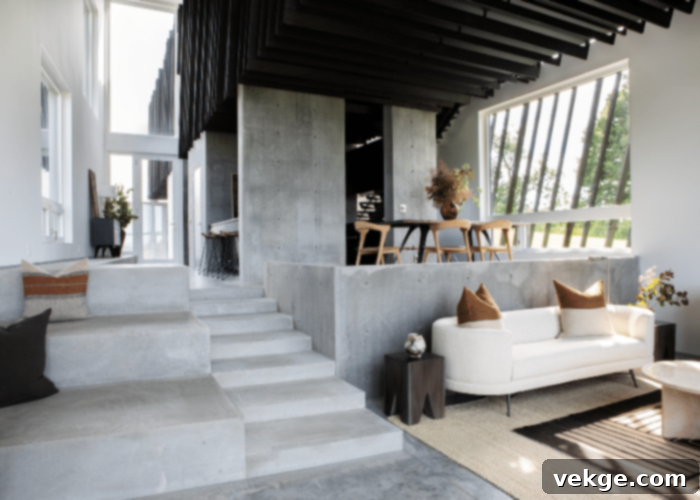
While commonly associated with structural construction, finely finished concrete can introduce a unique blend of coolness, calm, and striking modernity into minimalist spaces. The raw, unpainted yet impeccably smooth look of concrete offers an understated elegance that also has the practical benefit of making a room appear larger and more open. Its industrial aesthetic seamlessly blends with the minimalist emphasis on honesty of materials and simplicity of form.
- Flooring: Polished concrete floors are incredibly durable, easy to clean, and provide a cool, seamless foundation that anchors the minimalist design.
- Countertops: Concrete countertops in kitchens and bathrooms offer a sleek, continuous surface that speaks to contemporary design.
- Feature Walls: An exposed or subtly textured concrete accent wall can add significant architectural interest without introducing visual noise.
- Decorative Objects: Consider concrete planters, lamps, or small accent tables for a subtle, modern touch that complements the overall aesthetic.
Skilled professionals can even blend various shades of gray to achieve nuanced effects, demonstrating concrete’s surprising versatility. Beyond its visual appeal, concrete can contribute to thermal mass, helping to regulate indoor temperatures, and provides excellent sound insulation, enhancing the peaceful atmosphere of a minimalist home.
3. Steel: The Epitome of Sleek Durability
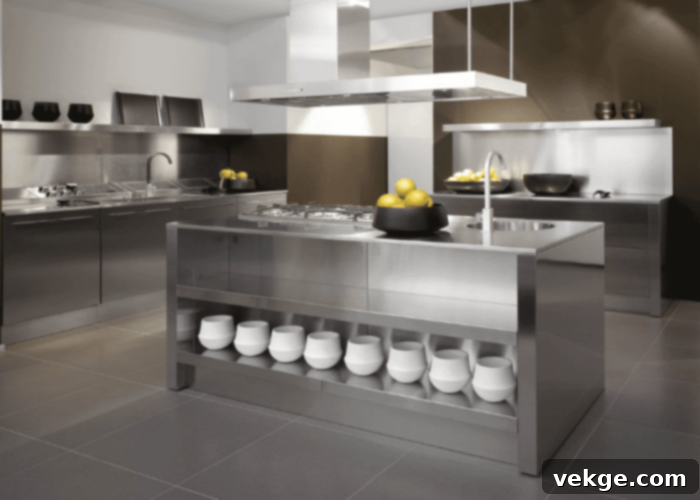
While perhaps not the most obvious choice for every component of a minimalist home, steel’s inherent sturdiness, clean lines, and immutable appearance make it an exceptional material for specific applications. It champions efficiency and durability, requiring no additional decor to make a statement – it’s good to go by itself. Steel introduces a modern, often industrial, edge that beautifully contrasts with softer textures like wood or fabric, or complements the starkness of concrete.
- Kitchen Elements: Stainless steel appliances are a hallmark of modern minimalist kitchens, prized for their hygiene, durability, and reflective surfaces. Steel can also be used for sleek backsplashes or open shelving.
- Furniture Frames: Thin, elegant steel frames for tables, chairs, or shelving units offer visual lightness while maintaining incredible strength.
- Architectural Details: Minimalist steel handrails or banisters for staircases contribute to an open, contemporary aesthetic.
- Lighting and Accents: Steel can be incorporated into modern lighting fixtures or subtle decorative pieces, adding a touch of sophisticated gleam.
The advantage of steel lies in its low maintenance, long lifespan, and its ability to contribute a precise, almost architectural feel to various components in the kitchen, living room, or even dining areas, reinforcing the minimalist dedication to functionality and clean design.
4. Glass: Maximizing Light and Achieving Royal Elegance

Glass is the quintessential material for achieving a look of royalty, lightness, and expansive elegance in a minimalist home. Its most significant advantage is its transparency, which maximizes natural light, a cornerstone of minimalist design, and creates an incredible illusion of space. Glass elements integrate effortlessly into any room’s plan, enhancing its sophistication without adding visual weight or clutter.
- Architectural Divisions: Glass walls or sliding doors can create open, airy partitions between rooms or seamlessly connect interior spaces with the outdoors.
- Furniture: Glass dining tables, coffee tables, or desks appear to float, contributing to a sense of openness and lightness.
- Shelving: Glass shelves are visually unobtrusive, making stored items the focal point and preventing the space from feeling heavy or cramped.
- Decorative Accents: Simple glass vases, bottles, or art pieces reflect light beautifully, adding subtle sparkle and refinement.
The only notable considerations with glass are its relative fragility and the need for regular cleaning to maintain its pristine, reflective quality. However, its unparalleled ability to enhance natural light and spatial perception makes it an invaluable asset in crafting a truly elegant and expansive minimalist environment.
5. Recycled Materials: Sustainable Character and Intentional Living
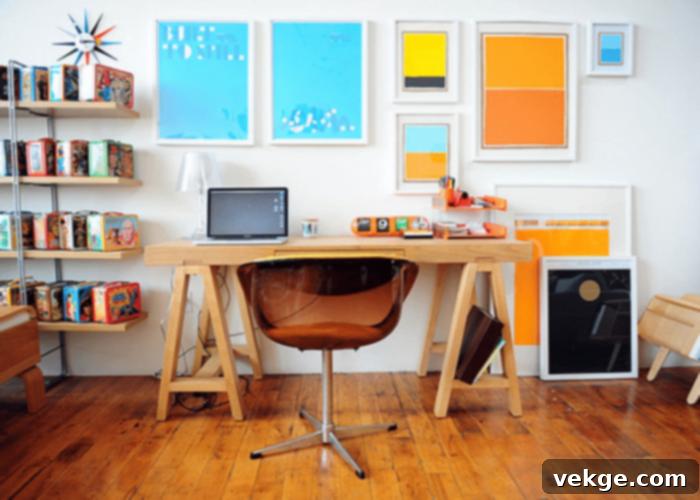
At the very core of minimalism lies the principle of wasting less and utilizing only what is necessary and meaningful. What better way to embody sustainable minimalism than by repurposing old objects into new, functional, and aesthetically pleasing elements within your home? This approach allows you to save both money and resources while imbuing your space with unique character and a story.
- Reclaimed Wood: Salvaged wood from old barns, pallets, or even discarded furniture can be transformed into stunning feature walls, custom tabletops, shelving, or unique flooring. Each piece carries a history and adds unparalleled warmth.
- Upcycled Metal: Industrial pipes can be repurposed into sturdy shelving units or clothing racks. Old metal containers might find new life as stylish planters or creative storage solutions, bringing an industrial-chic vibe.
- Repurposed Textiles: Breathe new life into old fabrics by converting them into distinctive cushion covers, throw blankets, or even unique textile art.
- DIY Projects with Found Objects: As illustrated, an old wheelbarrow can be charmingly repurposed as a garden flower bed. Similarly, vintage suitcases can become unique storage chests, and old wooden crates can be stacked to create rustic bookshelves or bedside tables.
Incorporating recycled materials demonstrates a commitment to environmentally conscious living and proves that minimalism doesn’t have to mean a sterile environment. Instead, it encourages creativity, individuality, and a deeper connection to the items in your home.
The Foundational Principles Of Minimalism in Home Design
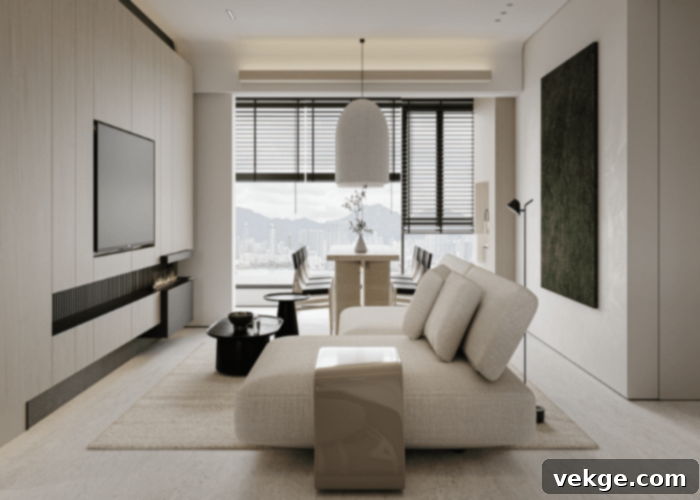
To fully grasp the nuances of minimalist decor and create a truly harmonious space, it’s crucial to understand the basic principles that form the bedrock of this design philosophy. These core ideas guide every decision, ensuring that your home not only looks minimalist but also embodies its values of clarity, purpose, and calm. Here are our top recommendations that will help you understand different minimalist decor approaches.
- Less Is More: The Essence of Intentional Living: As the guiding mantra, “Less is More” profoundly influences minimalist design. It means a home should not be cluttered with superfluous items but rather be efficient, practical, and visually serene. Every item is chosen with intention, serving a clear purpose or contributing to a sense of peace and beauty. It encourages thoughtful curation over accumulation.
- Reductive Design: Stripping to the Bare Essentials: In an era where modern decor can sometimes be overcomplicated for the sake of novelty, minimalist design embraces reductive principles. This involves paring down objects to their fundamental forms, removing any unnecessary embellishments or elaborate detailing. The focus shifts to the inherent beauty of materials, clean silhouettes, and unadulterated functionality.
- Clean & Sleek Lines: Promoting Visual Calm: Nothing conveys modern elegance and order quite like clean, sleek lines. These straight, uncluttered lines – whether in furniture, architectural features, or room layouts – are a hallmark of minimalist interiors. They not only contribute to a sophisticated aesthetic but also create a powerful illusion of spaciousness and an overall sense of calm and clarity within the environment.
- Functionality First: Purpose-Driven Design: Every element in a minimalist home must serve a practical purpose. Before considering aesthetics, the utility and efficiency of an object are prioritized. This principle dictates furniture choices, storage solutions, and even the layout of a room, ensuring the space works seamlessly for its inhabitants.
- Quality Over Quantity: Investing in Durability: Instead of filling a home with many disposable items, minimalism advocates for investing in fewer, high-quality pieces. These items are chosen for their durability, craftsmanship, and timeless appeal, reducing the need for frequent replacements and supporting a more sustainable consumption pattern.
- Clarity and Openness: Fostering Mental Well-being: The ultimate goal of these principles is to create a living environment that promotes mental clarity and reduces stress. By minimizing visual noise and embracing open spaces, natural light, and a sense of order, a minimalist home becomes a sanctuary that supports focus, relaxation, and overall well-being.
Which Aesthetics Should Be Followed for a Perfect Minimalist Home?
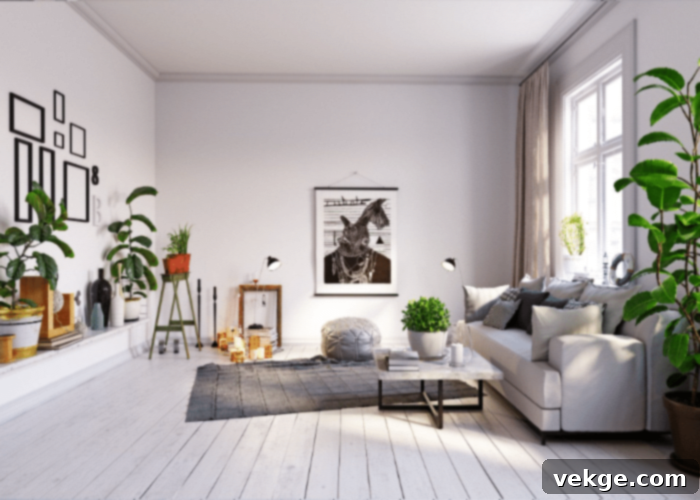
When translating minimalist principles into tangible interior design, several consistent aesthetic themes emerge that are crucial for elevating a room’s elegance and maintaining the style’s core essence. These popular aesthetics work in harmony to create a space that feels perfectly minimalist—calm, uncluttered, and inspiring.
- Simple Lines: The Visual Language of Minimalism: As a fundamental aesthetic, the use of simple, clean lines in furniture, architecture, and overall layout is paramount. Avoid intricate designs or ornate details; instead, focus on smooth, unadorned surfaces and geometric forms that promote visual clarity and a sense of order.
- Neutral Color Palettes: A Foundation of Calm: Minimalist spaces predominantly feature a neutral color scheme. Think whites, off-whites, various shades of gray, beige, and muted earth tones. These palettes create a serene, expansive backdrop, reflect natural light beautifully, and provide a versatile canvas for textures to stand out. While predominantly neutral, subtle pops of color can be introduced through carefully selected artwork or natural elements like plants.
- Limited, Multi-functional Furniture: Every piece of furniture in a minimalist home is chosen with purpose. Opt for essential items that serve multiple functions (e.g., an ottoman with storage, a sofa that converts) and fit the scale of the room. The emphasis is on quality over quantity, with pieces that have clean lines and are strategically placed to ensure ample open space and easy movement.
- Curated Decor: Intentional Accents: Rather than an abundance of decorative objects, minimalist decor involves a few, highly intentional accents. This could be a striking piece of abstract art, a sculptural vase, or a single lush plant. Each item should either have significant meaning, serve a subtle function, or contribute significantly to the room’s aesthetic appeal without creating visual noise.
- Uncluttered Space: The Breathability Factor: Perhaps the most recognizable aesthetic, an uncluttered space is central to minimalism. Surfaces are kept clear, floors free of obstacles, and every item has a designated, often hidden, storage spot. This lack of visual distraction creates a sense of calm and mental freedom, allowing the architectural features and chosen furnishings to truly stand out.
- Integrated Storage Solutions: Seamless Organization: To maintain an uncluttered environment, smart and often hidden storage solutions are vital. Think built-in wardrobes, custom cabinetry that blends with the walls, storage beds, and minimalist shelving units. These solutions keep necessities out of sight, preserving the clean lines and serene atmosphere.
- Open Floor Plans: Enhancing Flow and Light: Many minimalist homes benefit from open-concept layouts. This design choice maximizes natural light, creates a seamless flow between living areas, and significantly enhances the perception of space. Open floor plans encourage a sense of connection and an airy ambiance.
- Maximum Natural Lighting: Brightening the Soul: Abundant natural light is a non-negotiable aesthetic in minimalist design. Large windows, minimal window treatments (sheer curtains or blinds), and strategically placed mirrors are used to draw in and reflect light, brightening the space, highlighting textures, and uplifting the overall mood.
Lastly, irrespective of these suggestions, remember that your personal touch is paramount. Any minimalist decor can only truly come alive and feel like home when infused with your unique creativity and expression of personality, ensuring the space resonates with your soul.
Final Words: Embracing the Minimalist Lifestyle
Minimalism has rapidly evolved beyond a mere design trend to become a profound lifestyle choice that advocates for a more efficient, practical, and mindful way of living. At its core lies the powerful and transformative idea that “Less is More,” guiding us to curate spaces that foster clarity, calm, and genuine well-being.
Achieving a perfectly minimalist aesthetic involves understanding foundational principles such as reductive design, prioritizing functionality, and embracing consistent aesthetic themes like sleek lines, neutral color palettes, and inherently uncluttered spaces. By thoughtfully selecting materials such as warm, organic wood; modern, robust concrete; sleek, durable steel; expansive, elegant glass; and characterful recycled materials, you can create a home that is rich in texture and depth without succumbing to visual noise or excess.
By applying practical strategies like the ’90-day rule’ for decluttering, prioritizing intelligent integrated storage solutions, and maximizing the inflow of natural light, you can cultivate a home environment that is not only visually stunning but also deeply resonant with your desire for simplicity and peace. We’re curious: which aspects of minimalist decor resonate most with you, or which materials are you most excited to incorporate into your living space? Let us know your favorite minimalist decor ideas and inspirations in the comments section below!
